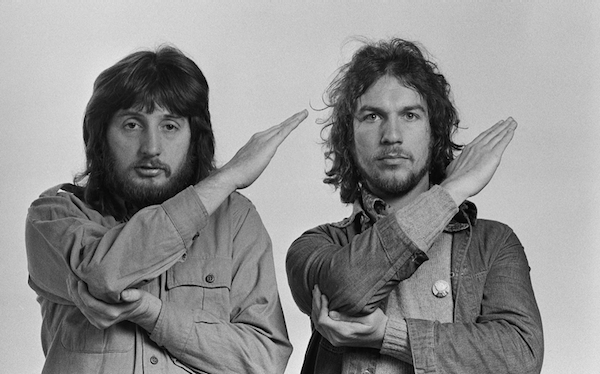Movie review by Greg Carlson
Dutch photographer, music video creator, and film director Anton Corbijn – now in his late 60s – brings his artistic insider touch to “Squaring the Circle: The Story of Hipgnosis,” an engaging and entertaining documentary examination of the massively influential team responsible for some of the most recognizable album covers of the 1970s. Suited to the likes of rock fans and graphic design geeks (and especially the sizable demographic that includes both), the movie is also the story of the personal and creative friendship between two maverick visionaries: the late Storm Thorgerson and Aubrey “Po” Powell.
While Thorgerson and Powell may not be household names to the millions who have purchased one or more albums featuring their handiwork, they are – in several significant ways – rock stars to the rock stars who hired, trusted, and championed them. Corbijn includes interviews with Robert Plant, Jimmy Page, Roger Waters, David Gilmour, Nick Mason, Paul McCartney, Peter Gabriel, and others who marveled at the stunning results that would come to visually represent groups like Pink Floyd and Led Zeppelin in equal measure to the sonic signatures inside the sleeves.
Watching “Squaring the Circle,” one gets the distinct feeling that Corbijn simply made the movie he wanted to see. All the juiciest stories, legendary productions, and thorny conflicts are collected and laid out like a lavishly illustrated, oversize coffee table tome come to life. Undoubtedly, a number of viewers who seek out the film – now available to stream following a 2022 world premiere at Telluride and a subsequent screening at the 2023 Sundance Film Festival – already own one or more of the several books devoted to archiving the Hipgnosis aesthetic.
In a time before Photoshop, Hipgnosis relied on analog tools and fierce commitment to achieve impressive results. Complicated and expensive photoshoots (some humorously recounted here) were standard operating procedure for many of the firm’s collaborations, but post-production image manipulation through airbrushing, multiple exposure, and good old fashioned cut-and-paste contributed to the magic. There are several candidates one could consider for the heavyweight title, but it is in no way possible to fully account for the Hipgnosis phenomenon without mentioning “The Dark Side of the Moon.”
George Hardie’s simple and elegant depiction of white light separated into a rainbow after passing through a prism was inspired by a photo Thorgerson saw in an old physics textbook, but like so many of the arresting pieces to emerge from the Hipgnosis shop, the art worked in complementary tandem with the recording, engaging in a kind of conversation with and extension of the ideas contained in the songs. This interplay could be found in the most successful Hipgnosis projects, which often added humor, puns, and layered meanings – some obvious, some obscure, and some not appreciated by clients – to the experience.
“Squaring the Circle” follows several concert films and underrated narrative features (“Control” and “The American” among them) by Corbijn, who has enjoyed fruitful partnerships with Depeche Mode and U2 that stretch back to the 1980s. His own evocative photography represents a stylistic contrast to Hipgnosis, but the director’s sincere appreciation for their pioneering accomplishments can be seen in the admiration and respect that went into assembling the movie.
